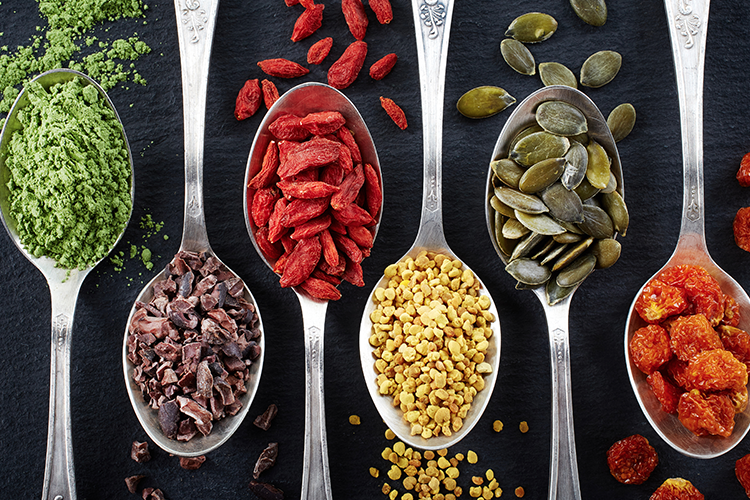Blog
Making baking and blending with whole foods affordable
 We had a question from a follower recently, asking for ideas on how to make desserts healthy, but don’t cost the earth.
We had a question from a follower recently, asking for ideas on how to make desserts healthy, but don’t cost the earth.
A perfectly reasonable question! So we have compiled a few tips for you to consider, to enjoy your treats and time in the kitchen without completely breaking the bank.
The whole food investment
Now, we bang on here about subbing the heavily processed and packaged foods for ‘real, whole foods’. What is great is eating a well planned menu of whole foods can be done on a budget, and overall has been found to be more affordable than eating convenience foods!1
But what about all the fancy and alternative foods out there for healthier whole food baked and blended kitchen creations, like buckwheat or besan flours, chia or hemp seeds, matcha or raw cacao powders? Many of these ingredients are not cheap, at least not compared to your stock standard bleached and heavily refined white flour and sugar!
Sure, switching from conventional dessert ingredients may be a little more expensive at first. But consider this an investment in your health. Using ingredients that are less processed and as close to nature as possible will be far better for you in the long run.2
Yet there are affordable ways to create great treat and dessert delights! And here are a few suggestions.
Higher quality
Buying foods that are higher in nutritional quality tend to satisfy you quicker. For example:
- Instead of white flour, use whole oats you have ground into a flour with a blender. Oats will offer more fibre, lower glycemic load, and an array of other benefits such as naturally lowering cholesterol levels.3
- Eating good quality dark chocolate over a Cadbury Dairy Milk counterpart means you are likely to eat less overall. Cacao beans are packed with antioxidants, and you get a bonus boost of healthy fats, especially when enjoyed with some nuts!4
Use fruit as the sweetener
Fruit needn’t be expensive, and it is filling and satisfying! Using mashed bananas a little dried fruit, or stewed apples and incorporating into baking can be delicious! For example:
- Apples cooked down into a sauce can be used in a 1:1 ratio for sugar, but adjust the liquid ratio on the recipe, trying ¼ less liquid for every 1 cup of applesauce.
- Banana and avocado can offer creaminess, fibre and a whole heap of beneficial nutrients in place of a highly processed vegetable oil.
Buy in bulk
Try and find a bulk bin supplier of ingredients. Some are more expensive than others, but generally buying ingredients like cacao powder, almond meal or coconut flour is going to be cheaper at places such as these than at the supermarket, or buying them in smaller packets at the health food store.
You could buy in bulk with a mate, and split the costs. You may even have a local co-op that could supply even cheaper per/kg costs!
Slowly stock the pantry
A good way to start building a whole food based pantry is buying one ingredient in bulk each week or pay cycle. Invest in 1kg of cacao one week, then the next round buy 1kg of cashews, the next round buy a couple of kilos of buckwheat flour, as an example.
Enjoying your food
Ultimately, we want to enjoy food! Instead of scrutinizing the nutrients, adhering to a strict regime, or counting every kilojoule* embrace the eating of real, whole foods with an attitude of including stuff that will give to you, rather than take.
You can choose to nourish your body and soul with every food decision you make. Nutrient value can take care of itself when you focus on real foods, especially within the Michael Pollan context to ‘eat food, not too much, mostly plants’.5
However, don’t beat yourself up when you eat that doughnut or slice of praline-layered-self-saucing-caramel-chocolate-mud birthday cake. No-one is perfect, nor should we expect ourselves to be.
By Angela Johnson (BHSc Nut. Med.)
* Unless you’ve a specific medical condition you are working on with a healthcare professional.
References:
- McDermott, AJ, & Stephens, MB 2010, ‘Cost of eating: whole foods versus convenience foods in a low-income model’, Family Medicine, vol. 42, no. 4, pp. 280-284.
- Katz, DL, & Meller, S 2014, ‘Can we say what diet is best for health?’, Annual Review of Public Health, vol. 35, pp. 83-103 21p.
- Whitehead, A, Beck, EJ, Tosh, S, & Wolever, TS 2014, ‘Cholesterol-lowering effects of oat β-glucan: a meta-analysis of randomized controlled trials’, The American Journal Of Clinical Nutrition, vol. 100, no. 6, pp. 1413-1421.
- S. Department of Agriculture, Agricultural Research Service 2010, Oxygen Radical Absorbance Capacity (ORAC) of Selected Foods, Release 2, Nutrient Data Laboratory Home Page: http://www.ars.usda.gov/nutrientdata/orac
- Pollan, M 2007, ‘Unhappy meals’, NY Times, viewed 28 July 2016, <http://www.nytimes.com/2007/01/28/magazine/28nutritionism.t.html?pagewanted=all&_r=0>











